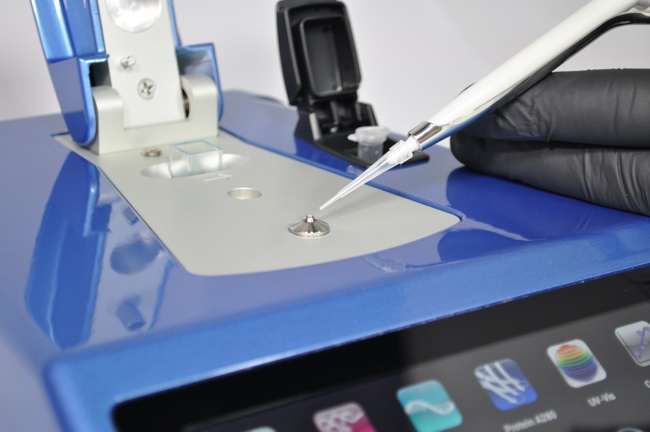Fluorescence microscopy is a widely used technique in molecular and cellular biology which is employed for both spatial analysis and to observe the interactions between various components of an organism. Fluorescent imaging micrographs are usually a qualitative process; however, fluorescence quantification can take place by using the light intensities of each pixel of the detector (e.g CCD, CMOS) to extract numeric data from images.
Here we will explore a few common scenarios where fluorescence quantification is used. In the interest of clarity, we will explore some general uses before narrowing down to key applications of DeNovix fluorescence quantification solutions.
Fluorescence Quantification for Cancer Diagnosis
Fluorescence quantification can be used with human tissues. Early tumors frequently grow on tissues that have a fast turnover and regeneration of cells, such as transformed mucosa, on the surface of hollow organs. Fluorescence quantification means that near real-time diagnoses can be made without adverse side effects.
One form of fluorescence quantification for cancer diagnoses involves the administration of a drug such as hematoporphyrin derivative (HpD), which is selectively retained by the tumor. This is then excited with light of a specific wavelength, and the drug which has been localized in the tumor fluoresces and is used for detection and imaging of tumors.
Fluorescence Quantification for Studying of Marine Petroleum Pollutants
Fluorescence quantification can be used to detect oil slicks on the surface of water, identifying specific petroleum derivative compounds and determining their sources. The key components of oils are hydrocarbons, and the other components are derivatives of hydrocarbons which are made up of single atoms of sulfur, oxygen and nitrogen.
Not all of these hydrocarbons fluoresce, and many of them show no ability to luminescence whatsoever. Petroleum absorbs radiation strongly, particularly ultraviolet and blue light. Petroleum is a luminescent medium, meaning that fluorescence quantification can be used to test oils. Fluorescence of oils typically covers a spectral area in the ultraviolet and visible range. The phenomenon is most significant in the 270–400 nm range.
Fluorescence Quantification for the Determination of Glucose
Glucose is an important element of animal and plant carbohydrates in biological systems. Blood glucose levels are also a significant element of determining human health conditions. Abnormal levels of glucose in the blood can provide critical information regarding diseases such as diabetes or hypoglycemia. Fluorescence quantification is ideal for determining levels of glucose as it is simple and highly sensitive. Bio-molecule stabilized Au nanoclusters have been demonstrated as a novel fluorescence probe for selective and sensitive detection of glucose.
Fluorescence Quantification Solutions from DeNovix
CellDrop Automated Cell Counters
CellDrop Automated Cell Counters use patented DirectPipette™ Technology to Count Cells Without Slides, eliminating the need for plastic consumables or inconvenient hemocytometers from routine cell counting. CellDrop Cell Counters use dual fluorescence and brightfield optics, a unique, variable height sample chamber, and easy-to-use analysis software to simplify the automation of routine cell counting. Our automated cell counters serve a wide range of life science applications, but in fluorescence mode, the CellDrop is particularly well-suited to the study of primary cells, assessing cell viability, identifying nucleated cells or isolated nuclei, testing transfection efficiency, and more.
DS-11 Series Spectrophotometer / Fluorometer
The DS-11 Series is a simple to use, compact instrument which offers full spectrum microvolume and cuvette UV-Vis analysis and fluorescence capability integrated into a single instrument. This instrument is ideal for labs requiring rapid nucleic acid and protein quantification and sample quality control. The DS-11 Series has an industry-leading lower detection limits of 0.75 ng/uL dsDNA, 0.60 ng/uL RNA or 0.04 mg/mL BSA and can measure samples with absorbance values at as much as 750 absorbance units (at a 1 cm equivalent path length). This delivers an upper detection limit of 1125 mg/ml of BSA protein or 37500 ng/uL of dsDNA
At DeNovix, we consider ourselves at the forefront of fluorescence quantification technology. If you would like to find out more, contact us today.



